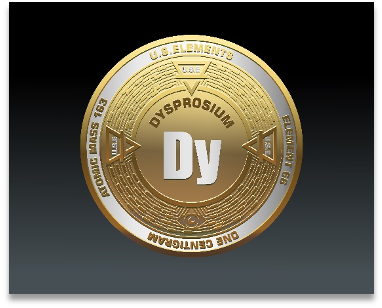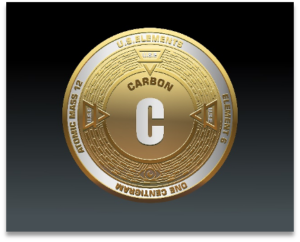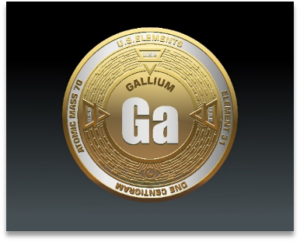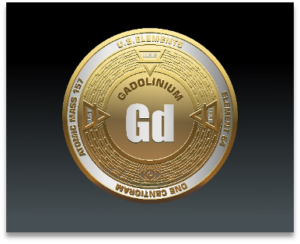Did you know that dysprosium, a rare earth element, is crucial to the performance of electric vehicle (EV) motors and wind turbines? This underappreciated element may only make up a tiny fraction of the Earth’s crust, but its role in advancing clean energy technology and national defense systems makes it indispensable to America’s future. In this, the eleventh article of our Critical Minerals Series, we’ll explore why dysprosium is a critical mineral that the U.S. must prioritize securing.
Why the U.S. Needs It:
Dysprosium is classified as a rare earth element and plays an essential role in advanced technological applications. Its most significant use is in the production of high-performance permanent magnets, which are used in electric motors, including those powering electric vehicles (EVs), wind turbines, and other renewable energy systems. Dysprosium’s ability to improve the temperature stability and efficiency of magnets makes it a key material for industries aiming to reduce greenhouse gas emissions and shift toward more sustainable energy sources.
Beyond clean energy, dysprosium is also critical in defense technologies. It is used in advanced guidance systems, lasers, and various military-grade electronics. As the U.S. military modernizes its capabilities, the demand for dysprosium will only increase, underscoring its strategic importance to national security.
Where It’s Found Domestically:
While dysprosium is considered rare, it is found in small quantities within the Earth’s crust, often as a byproduct of mining other rare earth elements, such as lanthanum and cerium. In the United States, however, there are limited active sources of dysprosium. Most of the U.S. supply is imported, primarily from China, which dominates the global rare earth element market. However, there are domestic efforts underway to develop rare earth mining operations and processing facilities, particularly in states like California and Texas, that could help reduce dependency on foreign sources.
One of the promising developments in the U.S. is the potential to extract dysprosium from existing mine tailings and other waste materials, which could provide an environmentally friendly alternative to primary mining.
Economic Realities:
Dysprosium’s market value is relatively high compared to many other minerals due to its rarity and importance in high-tech applications. As of recent estimates, dysprosium prices can fluctuate based on demand from the renewable energy sector and geopolitical events that may disrupt supply chains.
The U.S. currently imports a large portion of its dysprosium supply from China. This dependency raises concerns about market stability, as any disruption in China’s supply chain could have cascading effects on industries reliant on this mineral. As a result, developing alternative domestic sources is not just an economic opportunity but a national security necessity.
Processing and Technological Innovations:
Dysprosium is typically extracted through complex processes that involve the separation of rare earth elements from other ores. These processes are energy-intensive, and refining dysprosium requires specialized equipment and expertise. As such, there are ongoing research initiatives to develop more efficient and environmentally sustainable methods of extraction.
Innovative technologies in recycling and waste recovery are also making it possible to recover dysprosium from electronic waste, such as old hard drives and smartphones. This recycling approach could reduce the need for primary mining and ensure a more circular economy.
Abundance and Waste Recovery Potential:
Dysprosium is relatively scarce in nature, with an average concentration in the Earth’s crust of about 0.0006 parts per million. While this makes it difficult to find in large quantities, its recovery from mine tailings or recycled electronic materials could provide a more sustainable supply. Advances in mining technologies and the growing focus on rare earth recycling are promising in terms of expanding the available supply.
Time to Market:
Once dysprosium is mined or recovered, it can be processed into usable forms, such as high-purity metals or alloys, which can take several months to a year. The timeline depends on the efficiency of the extraction and processing methods used, as well as market demand.
For industries like electric vehicle manufacturing and wind turbine production, this delay can create bottlenecks, especially when supply is limited or concentrated in foreign markets. Ensuring the U.S. has a more robust and reliable dysprosium supply chain is vital for meeting the growing demand for green technologies.
Current and Future Applications:
Dysprosium is critical to the transition to a green economy, playing a key role in renewable energy technologies. Electric vehicles, a cornerstone of sustainable transportation, rely on dysprosium-containing magnets for their high-efficiency motors. Similarly, wind turbines, another major source of clean energy, require dysprosium in their magnets to operate at optimal performance.
In the defense sector, dysprosium is used in radar and laser systems, as well as in advanced missile guidance technology. The growing demand for more advanced military technology makes dysprosium an essential material for national security.
Looking ahead, we may see new applications for dysprosium in emerging technologies, such as quantum computing and advanced communications systems, as scientists continue to discover novel uses for rare earth elements.
Impact on Everyday Life:
Though dysprosium is not something most Americans are familiar with, it quietly impacts their daily lives in powerful ways. From the smartphones in our pockets to the electric vehicles in our driveways, dysprosium contributes to the technological conveniences of modern life. Without it, many of the innovations driving the green revolution and national security would be far less efficient and effective.
Consequences of Supply Shortages:
A shortage of dysprosium in the U.S. would have wide-reaching implications. Not only could it stall the growth of clean energy technologies like electric vehicles and wind turbines, but it could also compromise the U.S. military’s technological edge. If America continues to rely heavily on imports, particularly from geopolitical adversaries like China, it risks becoming vulnerable to supply chain disruptions that could have severe economic and security consequences.
Import Dependence:
As it stands, the U.S. imports nearly 100% of its dysprosium from foreign sources, with China accounting for the majority of global production. This heavy reliance on foreign sources underscores the urgent need for a domestic supply chain for this critical mineral. In order to reduce dependence on potentially unstable foreign sources, the U.S. must invest in domestic exploration, extraction, and recycling efforts for dysprosium.
Conclusion:
Dysprosium may be a rare and often overlooked mineral, but it is undeniably crucial to the future of America’s clean energy transition, technological innovation, and national defense. To ensure the U.S. remains competitive on the global stage, it must secure a stable and sustainable supply of dysprosium. This includes investing in domestic mining, processing technologies, and recycling initiatives. As we continue to advance the green revolution and strengthen our national security, securing dysprosium will be vital in keeping America at the forefront of innovation.
The journey toward mineral independence continues, and dysprosium is a critical piece of the puzzle. Stay tuned for the next article in our series as we explore another key mineral essential to America’s future.






